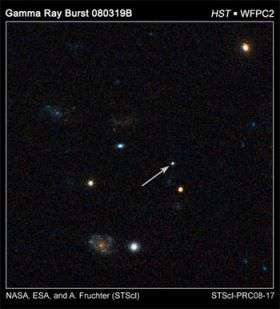Hubble Pinpoints Record-Breaking Explosion

Researchers working at the University of Warwick, with colleagues in Leicester University, ESA and NASA, have used NASA's Hubble Space Telescope to pin point what remains of what was the brightest naked-eye object ever seen from Earth. It is 7.5 billions light-years away halfway back to the big bang.
NASA's Hubble Space Telescope photographed the fading remnants of a powerful gamma ray burst that holds the record for being the brightest naked-eye object ever seen from Earth. For nearly a minute on March 19, this single "star" was as bright as 10 million galaxies.
Hubble Wide Field and Planetary Camera 2 (WFPC2) images taken on Monday, April 7 show the fading optical counterpart of the titanic blast.
Hubble astronomers had hoped to see the host galaxy where the burst presumably originated, but were taken aback that the light from the gamma ray burst is actually still drowning out the galaxy's light even three weeks after the explosion. Called a long-duration gamma ray burst, such events are theorized to be caused by the death of a very massive star, perhaps weighing as much as 50 times our Sun.
"The slow fading leaves astronomers puzzling about just where the energy came from to power this GRB, and makes Hubble's next observations of this object in May all the more crucial" said research team member Dr Andrew Levan of the University of Warwick.
Source: University of Warwick




















